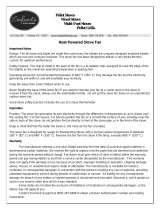
PELLET STOVES Chapter 1
INSTALLATION AND USE MANUAL
page 4
Introduction Technical service - Rights reserved MCZ S.p.A. - Reproduction prohibited
4.5. SETTINGS TO CARRY OUT BEFORE FIRST LIGHTING......................................................................35
4.5.1. SETTING CURRENT TIME........................................................................................................35
4.6. SELECTION OF RECIPE .................................................................................................................35
4.6.1. OPERATIONS FOR IDENTIFICATION OF THE RECIPE:...............................................................35
4.6.1.1. Identification of type of pellet...........................................................................................36
4.6.2. Procedure for recipe selection .................................................................................................36
4.6.3. Memorization of recipe on stove..............................................................................................36
4.7. CONTROL OF WATER TEMPERATURE IN BOILER ............................................................................37
4.8. FIRST LIGHTING ..........................................................................................................................37
4.8.1. Lighting the stove...................................................................................................................37
4.8.2. Extinguishing the stove...........................................................................................................38
4.9. VIEW OF THE FLAMES ..................................................................................................................38
4.9.1. The shape .............................................................................................................................38
4.9.2. The colour.............................................................................................................................39
4.9.3. The character ........................................................................................................................39
4.10. OPERATION..............................................................................................................................39
4.10.1. Operating concept...............................................................................................................39
4.10.2. Operating modes ................................................................................................................40
4.10.2.1. Internal thermostat - Position of internal room sensor........................................................41
4.10.2.2. Operation by means of external thermostat.......................................................................41
4.10.2.3. Connection of external thermostat....................................................................................41
4.10.3. Setting of ECO-STOP mode..................................................................................................41
4.10.3.1.
Activation /de-activation of ECO-STOP mode
.....................................................................43
4.10.3.2. OPERATION TO BE CARRIED OUT BY THE INSTALLER.......................................................43
4.10.4. Programmed mode (with timer) ...........................................................................................43
4.10.4.1.
Start day (code on display UT 01)
.....................................................................................43
4.10.4.2.
Clock (code on display UT 02 and UT 03)
..........................................................................44
4.10.4.3.
Programme
.....................................................................................................................45
4.11. EXAMPLE OF PROGRAMMING.....................................................................................................47
4.12. SAFETY DEVICES.......................................................................................................................49
4.12.1. Alarm signalling ..................................................................................................................51
4.12.2. Other signals on the display.................................................................................................52
4.12.3. Lockout of the stove............................................................................................................52
4.12.3.1.
Boiler bulb thermostat
.....................................................................................................52
4.12.3.2.
Pellet hopper safety thermostat
........................................................................................53
4.12.3.3.
Smoke expulsion
.............................................................................................................53
4.13. SHUTTING THE STOVE DOWN ...................................................................................................53
4.14. DOMESTIC WATER PRODUCTION KIT (optional) For POLAR-NOVA-ATHOS POWER stoves only.......54
5. MAINTENANCE AND CLEANING ......................................................................................................55
5.1. CLEANING TO BE PERFORMED BY THE USER..................................................................................55
5.1.1. Cleaning prior to each lighting.................................................................................................55
5.1.2. Check every 2/3 days .............................................................................................................55
5.1.3. Cleaning the glass..................................................................................................................55
5.1.4. Cleaning the heat exchanger and the pipe unit .........................................................................56
5.1.5. Cleaning of stainless steel and satin-finish surfaces...................................................................56
5.1.6. Cleaning of painted parts........................................................................................................56
5.2. CLEANING TO BE PERFORMED BY SPECIALIZED TECHNICIAN..........................................................57
5.2.1. Cleaning of the heat exchanger...............................................................................................57
5.2.2. Shutting the stove down (end of season) .................................................................................57
5.3. CHECK OF INTERNAL COMPONENTS..............................................................................................58
6. PROBLEMS / CAUSES / SOLUTIONS ...............................................................................................59
7. ELECTRICAL DIAGRAMS .................................................................................................................62
7.1. ELECTRICAL DIAGRAM OF POLAR-NOVA-ATHOS POWER Hydro WITH NO DOMESTIC HOT WATER KIT
62
7.2. ELECTRICAL DIAGRAM OF POLAR-NOVA-ATHOS POWER Hydro WITH DOMESTIC HOT WATER KIT....63
7.3. WIRING DIAGRAM for ATHOS Hydro without DOMESTIC HOT WATER KIT........................................64































